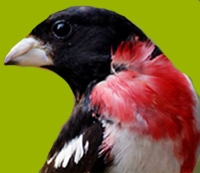
SCIENTIFIC NAME
Pheucticus ludovicianus
DESCRIPTION
With most birds, males are more brightly coloured, and this holds true with the rose-breasted grosbeak. The males are the most attractive with black backs and heads, white rumps and bellies and rose triangular patches on their breasts. The females, however, are not as conspicuous. Females have brown streaking on both their pale under parts and darker backs. Rose-breasted grosbeaks are said to have one of the prettiest calls. It is comparable to that of the American robin but with a more melodic sound.
RANGE
They have a broad distribution across southern Canada and can be found from British Columbia east to the Maritime Provinces. In northern Canada they are found in regions of the Yukon and Northwest Territories. Typically between August and September, rose-breasted grosbeaks begin their migration to Central and South America where they overwinter. They generally return to their Canadian range from the middle of April to late May.
HABITAT
Rose-breasted grosbeaks can be found in a range of habitats including deciduous and mixed woodlands along marshes, lakes, ponds and streams, and in pastures, parks and gardens.
DIET
Rose-breasted grosbeaks feed on insects, seeds, fruits and flower buds. Common items include beetles, bees, ants, crabapples, service berries, elderberries and Juneberries.
BEHAVIOUR
undefinedPRIMARY ECOSYSTEM ROLES
Photo Gallery
| Photo: Avro Poolar |
By Terri-Lee Reid
With most birds, males are more brightly coloured, and this holds true with the rose-breasted grosbeak. The males are the most attractive with black backs and heads, white rumps and bellies and rose triangular patches on their breasts. The females, however, are not as conspicuous. Females have brown streaking on both their pale under parts and darker backs.
Having rose-breasted grosbeaks in your backyard can be very beneficial. They feed on insects that cause damage to crops such as potato beetles and their larvae as well as weed seeds including foxtail and smartweed.
|
Photo: USFWS |
Rose-breasted grosbeaks are attracted to the seeds of maple, ash and pine. If you have these trees in your backyard you’re well on your way to providing an important food source for this bird. You can also lure them with the fruit of cherry, crabapple, serviceberry and elderberry. They visit bird feeders so their diet can be supplemented with the offering of sunflower seeds. Rose-breasted grosbeaks will also benefit from shrubs, such as hawthorn, or small trees, such as maple, which will provide important cover.
So the next time you see this beautiful bird, take a little time to enjoy its beauty and to listen for its song. It simply is a treat!
